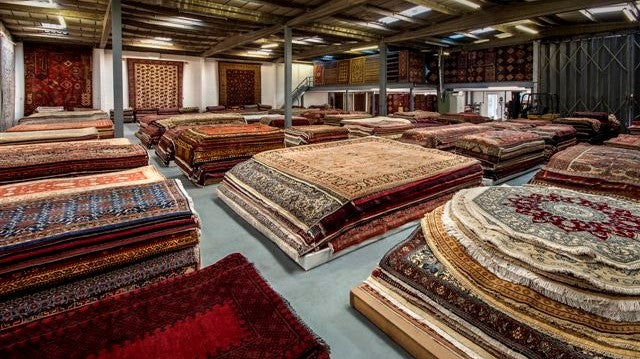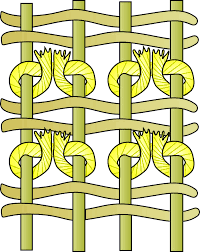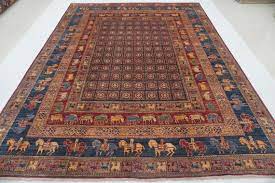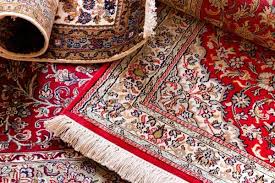The History of Rugs: From Ancient Times to Modern-Day

Rugs are one of the oldest and most versatile forms of human expression. They have been used for centuries to decorate, insulate, and protect floors, walls, and furniture. Rugs have also been a medium for artistic creativity, cultural identity, and religious symbolism. In this blog post, we will explore the history of rugs and how they have evolved throughout time from ancient civilizations to modern-day designs.
History Of Rugs
The earliest evidence of rug making dates back to the 3rd or 4th millennium BC, when nomadic tribes in Central Asia began to weave woolen fabrics using simple looms. These fabrics were used as clothing, blankets, tents, and saddle covers. Some of these fabrics were also decorated with geometric patterns or animal motifs using natural dyes. These early rugs were probably the ancestors of the flat-woven kilims that are still popular today.
Around the 1st millennium BC, a new technique of rug making emerged: the knotted-pile carpet. This technique changed the history of carpet forever and it involved tying knots of wool around two or more warp threads (vertical threads) to create a raised surface on the fabric. The knots could be varied in size, shape, color and density to create intricate designs and textures. The knotted-pile carpet was more durable and luxurious than the flat-woven fabric, and soon became a status symbol for the wealthy and powerful.

Pazyryk Rug
One of the oldest and most famous examples of a knotted-pile carpet is the Pazyryk carpet, which was discovered in 1949 in a royal tomb in the Pazyryk Valley of Siberia. The carpet dates back to around the 5th century BC and is attributed to the Scythian culture, a nomadic people who inhabited the Eurasian steppes. The carpet measures about 2 by 1.8 meters (6.6 by 5.9 feet) and has a density of about 3600 knots per square decimeter (232 knots per square inch). The carpet has a ribbon pattern in the center and a border with deer and horsemen motifs. The colors are vivid and varied, ranging from red and yellow to blue and green. The carpet is made of wool that was dyed with natural substances such as madder, indigo, cochineal, and walnut shell .

Persian Influence in Kashmir
Another ancient rugs culture that excelled in rug making was Persia (modern-day Iran). Persian rugs are renowned for their beauty, quality, and diversity. Persian rugs have been influenced by various historical periods, dynasties, regions, and religions. Some of the most famous types of Persian rugs include Tabriz, Isfahan, Kashan, Kerman, Heriz, Nain, Qom, Gabbeh, and Bakhtiari. Persian rugs typically feature floral, geometric, or pictorial designs with rich colors and intricate details. Persian rugs are also known for their use of silk, which adds a lustrous shine and softness to the woolen pile.
One of the most distinctive styles of Persian rugs is the Kashmiri rug. Kashmiri carpet history originated in the Kashmir region of India and Pakistan, where they were first woven by Persian immigrants in the 15th century. Kashmiri rugs are characterized by their fine knotting, delicate patterns, and soft colors. Kashmiri rugs often depict scenes from Persian literature, mythology, or history, such as hunting scenes or royal portraits. Kashmiri rugs are also famous for their use of pashmina wool, which is derived from a special breed of goat that lives in the high altitudes of the Himalayas.

Evolution of Rug Making Techniques
Rug making techniques have changed and evolved over time as well. One of the major innovations in rug making was the introduction of synthetic dyes in the 19th century. Synthetic dyes offered a wider range of colors and shades than natural dyes, but they also had some drawbacks such as fading or bleeding. Some rug makers preferred to stick to natural dyes or use a combination of both natural and synthetic dyes.
Another innovation in rug making was the development of machine-made rugs in the 20th century. With this came the birth of the mid century modern rug. Where modern rugs with abstract designs slowly started to become much more popular among your average person. Machine-made rugs are produced by automated looms that can weave faster and cheaper than hand-knotted rugs. Machine-made rugs can also replicate any design or pattern with precision and consistency.
Before the advent of machine made rugs, rugs were mostly hand-knotted or hand-woven by skilled artisans. This process was time-consuming, labor-intensive, and expensive. Only the wealthy and the elite could afford to buy and own such rugs. The designs and patterns of hand-made rugs were also limited by the availability of materials, the skill of the weavers, and the traditions of the regions where they were made.
Machine made rugs changed all that. They were produced by machines that could weave or tuft synthetic or natural fibers into rugs of various sizes, shapes, and colors. They were faster, cheaper, and easier to make than hand-made rugs. They also offered more variety and creativity in terms of designs and styles. Machine made rugs could mimic the look and feel of hand-made rugs, or create new and innovative patterns that were never seen before.
Machine made rugs opened up the rug market to a wider range of customers. They made rugs more accessible to people who could not afford or find hand-made rugs. They also created new opportunities for rug makers and sellers who could cater to different tastes and preferences. Machine made rugs transformed the rug industry from a niche and exclusive market to a mass and inclusive one.
Today, rug making is still a thriving art form that reflects both tradition and innovation. Modern rug designers draw inspiration from various sources such as history, culture, nature, art, fashion
SHARE:















